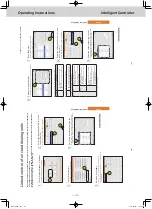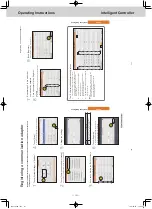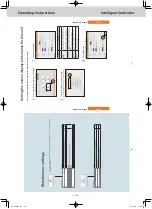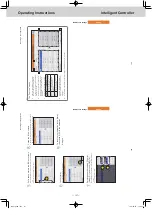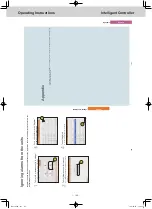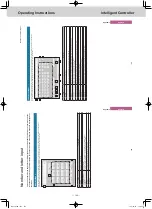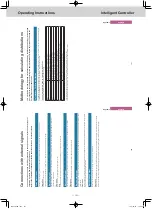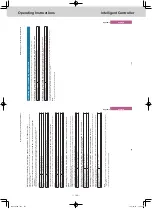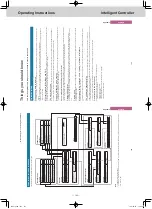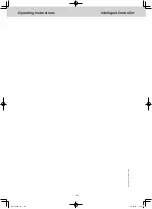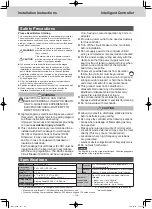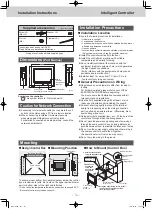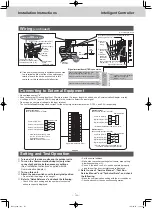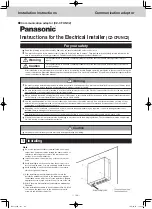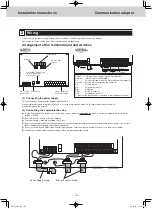
ー
141
ー
Operating Instructions
Intelligent Controller
190
Appendix
Appendix
Connections with external signals
You can measure the gas and electricity consumed by the unit and control all of the units by input or outputting signals to and from external equipments. Refer to the installation instructions for details about the electronics for external signals.
Pulse meter input
You can measure the gas and electricity consumed by connecting a
pulse meter (gas and/or fuel flow meter
, electricity meter).
Operation
A count is made for each pulse. You will need to set the consumption units (m
3
, kWh, or litres) per pulse in “Pulse meter settings” (P
.158).
Batch stop input
You can automatically stop all connected units with an external
signal (a fire alarm, for example). (Excluding those indoor unit
s set to be
excluded from the operation.)
Operation
When input is ON, the stop signal is sent to all indoor units.
Note
y
If batch stop input and batch startup input are ON simultaneously
, on the batch stop input is valid.
Batch startup input
You can automatically startup all units with an external signal. (Excluding those indoor units set to be excluded from the opera
tion.)
Operation
When the input signal switches from OFF to ON, the startup signal is sent to all indoor units.
Batch alarm output
When an alarm or error occurs on any of the connected units, this unit sends a signal externally
. This signal can be used by an alarm monitor or
similar device.
Operation
When an alarm or error occurs on any of the connected units, the intelligent controller signal to the external device is shorte
d. When the system
is restored, the intelligent controller signal is opened.
Batch startup output
When any of the connected units are running, this unit sends a signal externally
.
Operation
When any of the connected units (including interface adaptors) are running, the intelligent controller signal to the external d
evice is shorted.
When all connected units are stopped, the intelligent controller signal is opened. (Including when alarms or errors are occurri
ng)
191
Appendix
Appendix
Methodology for calculating distributions
This unit is able to make simplified calculations of air conditi
oning distribution and energy (electricity and
gas) usage with the cumulative operating time (thermostat ON/thermostat OFF) of indoor units and the performance values of indoor units.
Calculations for time distribution
Calculate the electricity/gas consumption index for indoor units individually or as a part of a distribution group, and calcula
te the electricity/gas
consumption distribution ratios for indoor units individually or as a part of an area group.
Types of parameters used to calculate distributions
The following parameters are used for calculating time distributing.
Parameter
Explanation
RHHi
The cumulative operating time of indoor unit No. i* (high)
RHi
The cumulative operating time of indoor unit No. i* (mid)
RLi
The cumulative operating time of indoor unit No. i* (low)
SHHi
The cumulative thermostat on time of indoor unit No. i* (high)
SHi
The cumulative thermostat on time of indoor unit No. i* (mid)
SLi
The cumulative thermostat on time of indoor unit No. i* (low)
Pi
The performance of indoor unit No. i* (a value equivalent to kW)
k
W
eighting coefficient for electricity when the thermostat is ON a
nd when it is OFF
αHH
W
eighting coefficient for fan speed when the speed is high
αH
W
eighting coefficient for fan speed when the speed is mid
αL
W
eighting coefficient for fan speed when the speed is low
*
Cumulative operating time is equal to thermostat ON cumulative time PLUS thermostat OFF cumulative time
If the distribution modes (P
.160) is set to “T
ime”, do not allocate P
AC and GHP
to the same distribution groups.
TGR-318_ENG.indb 141
2017/04/06 10:44:37

